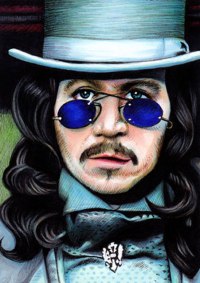Want to know more about the myth of the vampire? Or find out where Bram Stoker received his inspiration for Dracula?
This video is part of one of TED Ed’s lessons.
Did you know… Stoker wasn’t the first to write about vampires?
The vampire or revenant first appeared in poems such as The Vampire (1748) by Heinrich August Ossenfelder, Lenore (1773) by Gottfried August Bürger, Die Braut von Corinth The Bride of Corinth (1797) by Johann Wolfgang von Goethe, Robert Southey’s Thalaba the Destroyer (1801), John Stagg’s “The Vampyre” (1810), Percy Bysshe Shelley’s “The Spectral Horseman” (1810) (“Nor a yelling vampire reeking with gore”) and “Ballad” in St. Irvyne (1811) about a reanimated corpse, Sister Rosa, Samuel Taylor Coleridge’s unfinished Christabel and Lord Byron’s The Giaour.
[Source: Wikipedia]
1819 – John William Polidori, Lord Byron’s physician, published The Vampyre.
1847 – James Malcolm Rymer published the penny dreadful Varney the Vampire.
1871 – Joseph Sheridan Le Fanu published lesbian vampire story Carmilla.
1897 – Dracula was published 149 years after the first vampire writings.
Bram Stoker based his most famous main character on Vlad the Impaler.
Vlad III, Prince of Wallachia (1431–1476), was a member of the House of Drăculești, a branch of the House of Basarab, also known by his patronymic name: Dracula. He was posthumously dubbed Vlad the Impaler (Romanian: Vlad Țepeș pronounced [ˈvlad ˈt͡sepeʃ]), and was a three-time Voivode of Wallachia, ruling mainly from 1456 to 1462, the period of the incipient Ottoman conquest of the Balkans. His father, Vlad II Dracul, was a member of the Order of the Dragon, which was founded to protect Christianity in Eastern Europe. Vlad III is revered as a folk hero in Romania as well as other parts of Europe for his protection of the Romanian population both south and north of the Danube. A significant number of Romanian and Bulgarian common folk and remaining boyars (nobles) moved north of the Danube to Wallachia, recognized his leadership and settled there following his raids on the Ottomans.
[Source: Wikipedia]
 The iconic image of Gary Oldman’s incarnation of Dracula.
The iconic image of Gary Oldman’s incarnation of Dracula.
Stoker’s book has inspired many, many books and movie adaptations, and most recently TV series Dracula starring Jonathan Rhys Meyers.

Related articles:
- Wikipedia’s Vampire Literature
- Wikipedia’s Elizabeth Bathory, ‘the most prolific female serial killer’
I think there is a character in the Faerie Quene who might be seen as a vampire as well, and even in Beowulf there is a character who can only come out at night, who drinks blood and who has superhuman strength…
Great points, I think vampires and werewolves have been talked about as monsters for very, very long 🙂
LikeLike
I haven’t heard of The Faerie Queene before, but yes, vamps and vamp-like monsters and werewolves (Bisclavret, for example) do seem to appear in lit many hundreds of years ago.
LikeLike